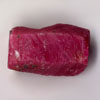- sale
- new items
- lovely beads
- wedding beads
- beads for teens
- for custom order
- newsletter
- recognition
- testimonials
- birthstones
- zodiac signs
- jewelry guide
SHOP BAG
![]() in your bag 0 items
in your bag 0 items
Ruby is a variety of the mineral corundum and is considered one of the four precious gems, with the sapphire, the emerald, and the diamond. Its name comes from RUBER (RUBENS, RUBINUS), Latin for red.
All natural rubies have imperfections in them, including color impurities and inclusions of rutile needles known as "silk". Gemologists use these needle inclusions found in natural rubies to distinguish them from synthetics, simulants, or substitutes. Usually the rough stone is heated before cutting. Almost all rubies today are treated in some form, with heat treatment being the most common practice.
Some rubies show a 3-point or 6-point asterism or star. These rubies are cut into cabochons to display the effect properly. Asterisms are best visible with a single-light source, and move across the stone as the light moves or the stone is rotated. Such effects occur when light is reflected off the silk (the structurally oriented rutile needle inclusions) in a certain way. This is one example where inclusions increase the value of a gemstone. Rubies can furthermore rarely show color changes and chatoyancy.
Rubies are mined in Myanmar (Burma), Thailand, Sri Lanka, Tanzania, Kenya, Madagascar, Cambodia, and Russia (Siberia), but they have also been found in the USA (Montana, North Carolina and South Carolina). The Mogok Valley in Upper Myanmar has produced some of the finest rubies, but in recent years very few good rubies have been found there. The unique color in Myanmar (Burmese) rubies is described as "pigeon's blood". They are known in the trade as "Mogok" rubies.
Although pieces of red corundum can be found weighing many kilograms, they are generally not of sufficient quality to be valuable as gemstones. For this reason, auction prices are the best indicator of a stone's true value, and prices correlate not only with size, but also with cut, origin, clarity and quality.
Rubies have always been held in high esteem in Asian countries. They were used to ornament armor, scabbards, and harnesses of noblemen in India and China. Rubies were laid beneath the foundation of buildings to secure good fortune to the structure. Ruby is considered to be a stone of passion. It's thought that when used properly, the negative aspects brought to the surface, will be dispelled. Zodiac signs of the ruby are: Cancer (Crab), Sagittarius (Archer), Leo (Lion).
Ruby facts
1. The famous lighted "Red Stars" mounted above Kremlin (Moscow, Russia) spires, thought to be giant rubies mined in Siberia, are colored glass.
2. An early recorded note of the transport and trading of rubies arises in the literature on the North Silk Road of China, where in about 100 BC rubies were carried along this ancient trackway moving westward from China.
3. Ruby is the most commonly named precious stone in English translations of the Bible
4. The Smithsonian's National Museum of Natural History in Washington DC, has received one of the world's largest and finest ruby gemstones. The spectacular 23.1-carat ruby was mined from the famous Mogok region of Burma (now Myanmar) in the 1930s, and set in a platinum ring with diamonds.
5. As of 2006, the record price paid at auction for a single stone was $5,860,000 for an unnamed 38.12 carat cabochon-cut ruby.



